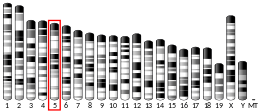Ameloblastin
Ameloblastin (abbreviated AMBN and also known as Sheathlin or Amelin) is an enamel matrix protein that in humans is encoded by the AMBN gene.[5]
Function
Ameloblastin, also known as amelin, is a gene-specific protein found in tooth enamel. Although less than 5% of enamel consists of protein, ameloblastins comprise 5–10% of all enamel protein. This protein is formed by ameloblasts during the early secretory to late maturation stages of amelogenesis. Although not completely understood, the function of ameloblastins is believed to be in controlling the elongation of enamel crystals and generally directing enamel mineralization during tooth development.
Other significant proteins in enamel are amelogenins, enamelins, and tuftelins.
This gene encodes the nonamelogenin enamel matrix protein ameloblastin. The encoded protein may be important in enamel matrix formation and mineralization. This gene is located in the calcium-binding phosphoprotein gene cluster on chromosome 4. Mutations in this gene may be associated with dentinogenesis imperfecta and autosomal dominant amelogenesis imperfecta. [provided by RefSeq, Aug 2011].
Clinical significance
Mutations in AMBN cause amelogenesis imperfecta.[6]
References
- GRCh38: Ensembl release 89: ENSG00000178522 - Ensembl, May 2017
- GRCm38: Ensembl release 89: ENSMUSG00000029288 - Ensembl, May 2017
- "Human PubMed Reference:". National Center for Biotechnology Information, U.S. National Library of Medicine.
- "Mouse PubMed Reference:". National Center for Biotechnology Information, U.S. National Library of Medicine.
- "Entrez Gene: Ameloblastin (enamel matrix protein)".
- Poulter JA, Murillo G, Brookes SJ, Smith CE, Parry DA, Silva S, Kirkham J, Inglehearn CF, Mighell AJ (October 2014). "Deletion of ameloblastin exon 6 is associated with amelogenesis imperfecta". Human Molecular Genetics. 23 (20): 5317–24. doi:10.1093/hmg/ddu247. PMC 4168819. PMID 24858907.
- This article incorporates text from the United States National Library of Medicine, which is in the public domain.
Further reading
- Bartlett JD, Simmer JP (1999). "Proteinases in developing dental enamel". Critical Reviews in Oral Biology and Medicine. 10 (4): 425–41. doi:10.1177/10454411990100040101. PMID 10634581.
- MacDougall M, DuPont BR, Simmons D, Reus B, Krebsbach P, Kärrman C, Holmgren G, Leach RJ, Forsman K (April 1997). "Ameloblastin gene (AMBN) maps within the critical region for autosomal dominant amelogenesis imperfecta at chromosome 4q21". Genomics. 41 (1): 115–8. doi:10.1006/geno.1997.4643. PMID 9126491.
- Kuroda S, Wazen R, Sellin K, Tanaka E, Moffatt P, Nanci A (July 2011). "Ameloblastin is not implicated in bone remodelling and repair". European Cells & Materials. 22: 56–66, discussion 66–7. PMID 21761392.
- Perdigão PF, Carvalho VM, DE Marco L, Gomez RS (August 2009). "Mutation of ameloblastin gene in calcifying epithelial odontogenic tumor". Anticancer Research. 29 (8): 3065–7. PMID 19661317.
- Tamburstuen MV, Reseland JE, Spahr A, Brookes SJ, Kvalheim G, Slaby I, Snead ML, Lyngstadaas SP (February 2011). "Ameloblastin expression and putative autoregulation in mesenchymal cells suggest a role in early bone formation and repair". Bone. 48 (2): 406–13. doi:10.1016/j.bone.2010.09.007. PMC 4469498. PMID 20854943.
- Toyosawa S, Fujiwara T, Ooshima T, Shintani S, Sato A, Ogawa Y, Sobue S, Ijuhin N (October 2000). "Cloning and characterization of the human ameloblastin gene". Gene. 256 (1–2): 1–11. doi:10.1016/s0378-1119(00)00379-6. PMID 11054529.
- Patir A, Seymen F, Yildirim M, Deeley K, Cooper ME, Marazita ML, Vieira AR (2008). "Enamel formation genes are associated with high caries experience in Turkish children". Caries Research. 42 (5): 394–400. doi:10.1159/000154785. PMC 2820320. PMID 18781068.
- Lee SK, Krebsbach PH, Matsuki Y, Nanci A, Yamada KM, Yamada Y (December 1996). "Ameloblastin expression in rat incisors and human tooth germs". The International Journal of Developmental Biology. 40 (6): 1141–50. PMID 9032019.
- Niu CH, Li TJ (November 2006). "[Mutation and polymorphism of the ameloblastin gene in ameloblastomas]". Zhonghua Kou Qiang Yi Xue Za Zhi = Zhonghua Kouqiang Yixue Zazhi = Chinese Journal of Stomatology (in Chinese). 41 (11): 678–81. PMID 17331365.



